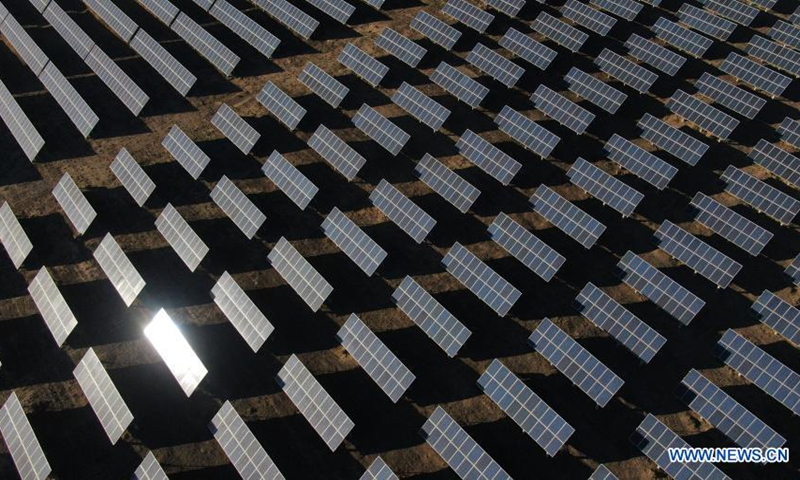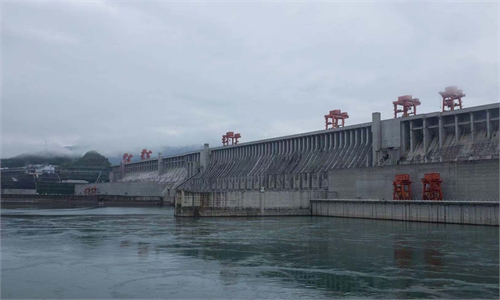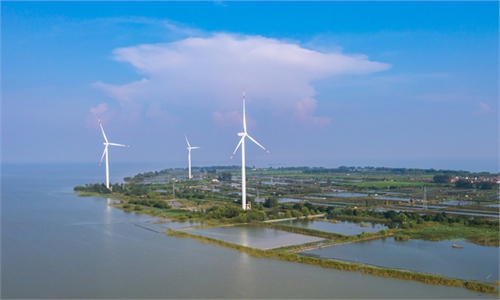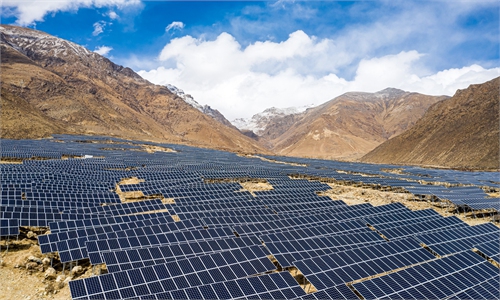China cuts carbon intensity by 34% in past decade, will further boost green development

Aerial photo taken on Dec. 15, 2020 shows a view of a photovoltaic industrial park in Gonghe County, Tibetan Autonomous Prefecture of Hainan in northwest China's Qinghai Province. (Xinhua/Zhang Hongxiang)
China has reduced its carbon intensity by 34 percent in the past decade and will do even more to encourage green development, Chinese officials said at a press conference on Thursday, as they sought to shed light on the country's efforts and achievements in coordinating economic and environmental development since the 18th National Congress of the Communist Party of China in 2012.The decline in carbon intensity is a hard-won achievement that underscores China's contribution to global carbon emissions reduction, and more investment in green development will boost economic growth and better protect the environment, experts noted.
Over the past decade, China's carbon intensity — a measure that shows carbon dioxide (CO2) emissions per unit of GDP — fell by 34 percent, and the total installed capacity of wind and solar power generation, along with the production and sales of new-energy vehicles, led the world, Han Wenxiu, an official with the Central Committee for Financial and Economic Affairs, said at the press conference on Thursday.
China has also made significant contributions to global cli-mate governance through its green development and participation in international negotiations. In the past decade, China played an active role in pushing forward the Paris Agreement and rolled out a roadmap for hitting peak emissions before 2030 and carbon neutrality by 2060, making important contributions to addressing climate change, Han said.
In 2021, China generated 2.48 trillion kilowatt hours of electricity from renewable sources, which accounted for 29.8 percent of total electricity consumption amid a drive to develop renewable energy and make the transition to a low-carbon economy, the Xinhua News Agency reported.
"It has been a decade of solid progress in green development with fewer haze-filled days and less black and unclean water, and more blue skies, white clouds, clear water and green mountains," Han said.
China's cumulative decline in carbon intensity in the past decade was a hard-won victory, making it one of the most efficient countries in reducing carbon emissions, Lin Boqiang, director of the China Center for Energy Economics Research at Xiamen University, told the Global Times on Thursday.
Despite recent domestic flare-ups of COVID-19 and global geopolitical tensions, the Chinese government has stepped up efforts to support the transition to low-carbon, high-quality development with increased renewable energy subsidies, sustainable infrastructure spending and green bond issuance.
China will vigorously develop the renewable energy industry and build 450 gigawatts (GW) of solar and wind power capacity in the Gobi and other desert regions, officials from the National Development and Reform Commission (NDRC) said on Thursday.
All coal-fired power units with power consumption of more than 300 grams of standard coal per kilowatt-hour should be upgraded, according to the NDRC.
The State Council, China's cabinet, announced on Wednesday plans to allocate 50 billion yuan ($7.36 billion) in renewable energy subsidies to electricity producers.
"The development of new infrastructure and new energy will be more closely integrated in the future. With the popularization of new energy, technological innovation and cost reduction, the new-energy sector could create more jobs and drive long-term economic growth," Lin said.
The government has been leveraging green bonds to support China's low-carbon transition, with the proceeds used to support clean transportation, green architecture, sustainable water resources and sewage treatment.
In 2021, China's domestic green bond issuance exceeded 600 billion yuan, up 180 percent year-on-year, ranking among the top in the world, a vice governor of the People's Bank of China, the central bank, said on Thursday.
The issuance of green bonds and other instruments are "conducive to the technological transition of traditional industries, which will be critical to China's economic transformation and industrial upgrading," Dong Dengxin, director of the Finance and Securities Institute of the Wuhan University of Science and Technology, told the Global Times on Thursday.



